- Home
- Oliver Sacks
The River of Consciousness Page 3
The River of Consciousness Read online
Page 3
The tree of life shows at a glance the antiquity and the kinship of all living organisms and how there is “descent with modification” (as Darwin originally called evolution) at every juncture. It shows too that evolution never stops, never repeats itself, never goes backwards. It shows the irrevocability of extinction—if a branch is cut off, a particular evolutionary path is lost forever.
I rejoice in the knowledge of my biological uniqueness and my biological antiquity and my biological kinship with all other forms of life. This knowledge roots me, allows me to feel at home in the natural world, to feel that I have my own sense of biological meaning, whatever my role in the cultural, human world. And although animal life is far more complex than vegetable life, and human life far more complex than the life of other animals, I trace back this sense of biological meaning to Darwin’s epiphany on the meaning of flowers, and to my own intimations of this in a London garden, nearly a lifetime ago.
Speed
As a boy, I was fascinated by speed, the wild range of speeds in the world around me. People moved at different speeds; animals much more so. The wings of insects moved too fast to see, though one could judge their frequency by the tone they emitted—a hateful noise, a high E, with mosquitoes, or a lovely bass hum with the fat bumblebees that flew around the hollyhocks each summer. Our pet tortoise, which could take an entire day to cross the lawn, seemed to live in a different time frame altogether. But what then of the movement of plants? I would come down to the garden in the morning and find the hollyhocks a little higher, the roses more entwined around their trellis, but, however patient I was, I could never catch them moving.
Experiences like this played a part in turning me to photography, which allowed me to alter the rate of motion, speed it up, slow it down, so I could see, adjusted to a human perceptual rate, details of movement or change otherwise beyond the power of the eye to register. Being fond of microscopes and telescopes (my older brothers, medical students and bird-watchers, kept theirs in the house), I thought of the slowing down or the speeding up of motion as a sort of temporal equivalent: slow motion as an enlargement, a microscopy of time, and speeded-up motion as a foreshortening, a telescopy of time.
I experimented with photographing plants. Ferns, in particular, had many attractions for me, not least in their tightly wound crosiers or fiddleheads, tense with contained time, like watch springs, with the future all rolled up in them. So I would set my camera on a tripod in the garden and take photographs of fiddleheads at hourly intervals; I would develop the negatives, print them up, and bind a dozen or so prints together in a little flick-book. And then, as if by magic, I could see the fiddleheads unfurl like the curled-up paper trumpets one blew into at parties, taking a second or two for what, in real time, took a couple of days.
Slowing down motion was not so easy as speeding it up, and here I depended on my cousin, a photographer, who had a cine camera capable of taking more than a hundred frames per second. With this, I was able to catch the bumblebees at work as they hovered in the hollyhocks and to slow down their time-blurred wing beats so that I could see each up-and-down movement distinctly.
My interest in speed and movement and time, and in possible ways to make them appear faster or slower, made me take a special pleasure in two of H. G. Wells’s stories, “The Time Machine” and “The New Accelerator,” with their vividly imagined, almost cinematic descriptions of altered time.
“As I put on pace, night followed day like the flapping of a black wing,” Wells’s Time Traveller relates:
I saw the sun hopping swiftly across the sky, leaping it every minute, and every minute marking a day….The slowest snail that ever crawled dashed by too fast for me….Presently, as I went on, still gaining velocity, the palpitation of night and day merged into one continuous greyness…the jerking sun became a streak of fire…the moon a fainter fluctuating band….I saw trees growing and changing like puffs of vapour…huge buildings rise up faint and fair, and pass like dreams. The whole surface of the earth seemed changed—melting and flowing under my eyes.
The opposite of this occurs in “The New Accelerator,” the story of a drug that accelerates one’s perceptions, thoughts, and metabolism several thousand times or so. Its inventor and the narrator, who have taken the drug together, wander out into a glaciated world, watching
people like ourselves and yet not like ourselves, frozen in careless attitudes, caught in mid-gesture….And sliding down the air with wings flapping slowly and at the speed of an exceptionally languid snail—was a bee.
“The Time Machine” was published in 1895, when there was intense interest in the new powers of photography and cinematography to reveal details of movements inaccessible to the unaided eye. Étienne-Jules Marey, a French physiologist, had been the first to show that a galloping horse at one point had all four hooves off the ground. His work, as the historian Marta Braun brings out, was instrumental in stimulating Eadweard Muybridge’s famous photographic studies of motion. Marey, in turn stimulated by Muybridge, went on to develop high-speed cameras that could slow and almost arrest the movements of birds and insects in flight and, at the opposite extreme, to use time-lapse photography to accelerate the otherwise almost imperceptible movements of sea urchins, starfish, and other marine animals.
I wondered sometimes whether the speeds of animals and plants could be very different from what they were: how much they were constrained by internal limits, how much by external—the gravity of the earth, the amount of energy received from the sun, the amount of oxygen in the atmosphere, and so on. So I was fascinated by yet another Wells story, The First Men in the Moon, with its beautiful description of how the growth of plants was dramatically accelerated on a celestial body with only a fraction of the earth’s gravity:
With a steady assurance, a swift deliberation, these amazing seeds thrust a rootlet downward to the earth and a queer little bundle-like bud into the air….The bundle-like buds swelled and strained and opened with a jerk, thrusting out a coronet of little sharp tips…that lengthened rapidly, lengthened visibly even as we watched. The movement was slower than any animal’s, swifter than any plant’s I have ever seen before. How can I suggest it to you—the way that growth went on?…Have you ever on a cold day taken a thermometer into your warm hand and watched the little thread of mercury creep up the tube? These moon plants grew like that.
Here, as in “The Time Machine” and “The New Accelerator,” the description was irresistibly cinematic and made me wonder if the young Wells had seen time-lapse photography of plants, or even experimented with it, as I had.
A few years later, when I was a student at Oxford, I read William James’s Principles of Psychology, and there, in a wonderful chapter on “The Perception of Time,” I found this description:
We have every reason to think that creatures may possibly differ enormously in the amounts of duration which they intuitively feel, and in the fineness of the events that may fill it. Von Baer has indulged in some interesting computations of the effect of such differences in changing the aspect of Nature. Suppose we were able, within the length of a second, to note 10,000 events distinctly, instead of barely 10, as now; if our life were then destined to hold the same number of impressions, it might be 1000 times as short. We should live less than a month, and personally know nothing of the change of seasons. If born in winter, we should believe in summer as we now believe in the heats of the Carboniferous era. The motions of organic beings would be so slow to our senses as to be inferred, not seen. The sun would stand still in the sky, the moon be almost free from change, and so on. But now reverse the hypothesis and suppose a being to get only one 1000th part of the sensations that we get in a given time, and consequently live 1000 times as long. Winters and summers will be to him like quarters of an hour. Mushrooms and the swifter-growing plants will shoot into being so rapidly as to appear instantaneous creations; annual shrubs will rise and fall from the earth like restlessly boiling water springs; the motions of animals will be as
invisible as are to us the movements of bullets and cannon-balls; the sun will scour through the sky like a meteor, leaving a fiery trail behind him, etc. That such imaginary cases (barring the superhuman longevity) may be realized somewhere in the animal kingdom, it would be rash to deny.
This was published in 1890, when Wells was a young biologist (and writer of biology texts). Could he have read James or, for that matter, the original computations of von Baer from the 1860s? Indeed, one might say that a cinematographic model is implicit in all these descriptions, for the business of registering larger or smaller numbers of events in a given time is exactly what cine cameras do if they are run faster or slower than the usual twenty-four or so frames per second.
It is often said that time seems to go more quickly, the years rush by, as one grows older—either because when one is young one’s days are packed with novel, exciting impressions or because as one grows older a year becomes a smaller and smaller fraction of one’s life. But if the years appear to pass more quickly, the hours and minutes do not; they are the same as they always were.
At least they seem so to me (in my seventies), although experiments have shown that while young people are remarkably accurate at estimating a span of three minutes by counting internally, elderly subjects apparently count more slowly, so that their perceived three minutes is closer to three and a half or four minutes. But it is not clear that this phenomenon has anything to do with the existential or psychological feeling of time passing more quickly as one ages.
The hours and minutes still seem excruciatingly long when I am bored and all too short when I am engaged. As a boy, I hated school, being forced to listen passively to droning teachers. When I looked at my watch surreptitiously, counting the minutes to my liberation, the minute hand, and even the second hand, seemed to move with infinite slowness. There is an exaggerated consciousness of time in such situations; indeed, when one is bored, there may be no consciousness of anything but time.
In contrast were the delights of experimenting and thinking in the little chemical lab I set up at home, and here, on a weekend, I might spend an entire day in happy activity and absorption. Then I would have no consciousness of time at all, until I began to have difficulty seeing what I was doing and realized that evening had come. When, years later, I read Hannah Arendt, writing (in The Life of the Mind) of “a timeless region, an eternal presence in complete quiet, lying beyond human clocks and calendars altogether…the quiet of the Now in the time-pressed, time-tossed existence of man….This small non-time space in the very heart of time,” I knew exactly what she was talking about.
There have always been anecdotal accounts of people’s perception of time when they are suddenly threatened with mortal danger, but the first systematic study was undertaken in 1892 by the Swiss geologist Albert Heim; he explored the mental states of thirty subjects who had survived falls in the Alps. “Mental activity became enormous, rising to a hundred-fold velocity,” Heim noted. “Time became greatly expanded….In many cases there followed a sudden review of the individual’s entire past.” In this situation, he wrote, there was “no anxiety” but rather “profound acceptance.”
Almost a century later, in the 1970s, Russell Noyes and Roy Kletti, of the University of Iowa, exhumed and translated Heim’s study and went on to collect and analyze more than two hundred accounts of such experiences. Most of their subjects, like Heim’s, described an increased speed of thought and an apparent slowing of time during what they thought to be their last moments.
A race-car driver who was thrown thirty feet into the air in a crash said, “It seemed like the whole thing took forever. Everything was in slow motion, and it seemed to me like I was a player on a stage and could see myself tumbling over and over…as though I sat in the stands and saw it all happening…but I was not frightened.” Another driver, cresting a hill at high speed and finding himself a hundred feet from a train which he was sure would kill him, observed, “As the train went by, I saw the engineer’s face. It was like a movie run slowly, so that the frames progress with a jerky motion. That was how I saw his face.”
While some of these near-death experiences are marked by a sense of helplessness and passivity, even dissociation, in others there is an intense sense of immediacy and reality, and a dramatic acceleration of thought and perception and reaction, which allow one to negotiate danger successfully. Noyes and Kletti describe a jet pilot who faced almost certain death when his plane was improperly launched from its carrier: “I vividly recalled, in a matter of about three seconds, over a dozen actions necessary to successful recovery of flight attitude. The procedures I needed were readily available. I had almost total recall and felt in complete control.”
Many of their subjects, Noyes and Kletti said, felt that “they performed feats, both mental and physical, of which they would ordinarily have been incapable.”
It may be similar, in a way, with trained athletes, especially those in games demanding fast reaction times.
A baseball may be approaching at close to a hundred miles per hour, and yet, as many people have described, the ball may seem to be almost immobile in the air, its very seams strikingly visible, and the batter finds himself in a suddenly enlarged and spacious timescape, where he has all the time he needs to hit the ball.
In a bicycle race, cyclists may be moving at nearly forty miles per hour, separated only by inches. The situation, to an onlooker, looks precarious in the extreme, and, indeed, the cyclists may be mere milliseconds away from each other. The slightest error might lead to a multiple crash. But to the cyclists themselves, concentrating intensely, everything seems to be moving in relatively slow motion, and there is ample room and time, enough to allow improvisation and intricate maneuverings.
The dazzling speed of martial arts masters, the movements too fast for the untrained eye to follow, may be executed, in the performer’s mind, with an almost balletic deliberation and grace, what trainers and coaches like to call relaxed concentration. This alteration in the perception of speed is often conveyed in movies like The Matrix by alternating accelerated and slowed-down versions of the action.
The expertise of athletes, whatever their innate gifts, is only to be acquired by years of dedicated practice and training. At first, an intense conscious effort and attention are necessary to learn every nuance of technique and timing. But at some point the basic skills and their neural representation become so ingrained in the nervous system as to be almost second nature, no longer in need of conscious effort or decision. One level of brain activity may be working automatically, while another, the conscious level, is fashioning a perception of time, a perception which is elastic and can be compressed or expanded.
In the 1960s, the neurophysiologist Benjamin Libet, investigating how simple motor decisions were made, found that brain signals indicating an act of decision could be detected several hundred milliseconds before there was any conscious awareness of it. A champion sprinter may be up and running and already sixteen or eighteen feet into the race before he is consciously aware that the starting gun has fired. He can be off the blocks in 130 milliseconds, whereas the conscious registration of the gunshot requires 400 milliseconds or more. The runner’s belief that he consciously heard the gun and then immediately exploded off the blocks is an illusion made possible, Libet would suggest, because the mind “antedates” the sound of the gun by almost half a second.
Such a reordering of time, like the apparent compression or expansion of time, raises the question of how we normally perceive time. William James speculated that our judgment of time, our speed of perception, depends on how many “events” we can perceive in a given unit of time.
There is much to suggest that conscious perception (at least visual perception) is not continuous but consists of discrete moments, like the frames of a movie, which are then blended to give an appearance of continuity. No such partitioning of time, it would seem, occurs in rapid, automatic actions such as returning a tennis shot or hitting a baseball. Christof
Koch, a neuroscientist, distinguishes between “behavior” and “experience” and proposes that “behavior may be executed in a smooth fashion, while experience may be structured in discrete intervals, as in a movie.” This model of consciousness would allow a Jamesian mechanism by which the perception of time could be speeded up or slowed down. Koch speculates that the apparent slowing of time in emergencies and athletic performances (at least when athletes find themselves “in the zone”) may come from the power of intense attention to reduce the duration of individual frames.
For William James, the most striking departures from “normal” time were provided by the effects of certain drugs. He tried a number of them himself, from nitrous oxide to peyote, and in his chapter on the perception of time he immediately followed his meditation on von Baer with a reference to hashish. “In hashish-intoxication,” he writes, “there is a curious increase in the apparent time-perspective. We utter a sentence, and ere the end is reached the beginning seems already to date from indefinitely long ago. We enter a short street, and it is as if we should never get to the end of it.”
James’s observations are an almost exact echo of Jacques-Joseph Moreau’s fifty years earlier. Moreau, a physician, was one of the first to make hashish fashionable in the Paris of the 1840s—indeed, he was a member, along with Gautier, Baudelaire, Balzac, and other savants and artists, of Le Club des Hachichins. Moreau wrote,
Crossing the covered passage in the Place de l’Opéra one night, I was struck by the length of time it took to get to the other side. I had taken a few steps at most, but it seemed to me that I had been there two or three hours….I hastened my step, but time did not pass more rapidly….It seemed to me…that the walk was endlessly long and that the exit towards which I walked was retreating into the distance at the same rate as my speed of walking.

 Uncle Tungsten
Uncle Tungsten Oaxaca Journal
Oaxaca Journal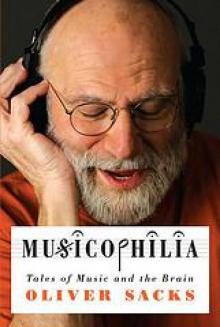 Musicophilia
Musicophilia The man who mistook his wife for a hat
The man who mistook his wife for a hat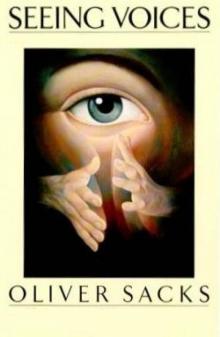 1989 - Seeing Voices
1989 - Seeing Voices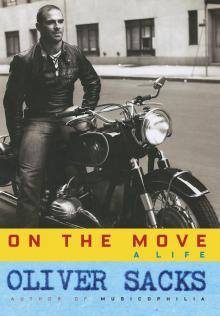 On the Move: A Life
On the Move: A Life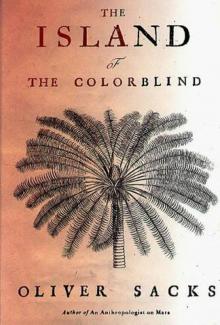 1996 - The Island of the Colorblind
1996 - The Island of the Colorblind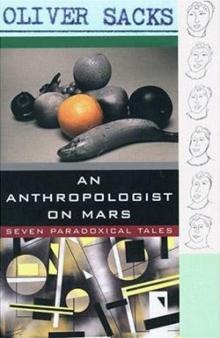 An Anthropologist on Mars: Seven Paradoxical Tales
An Anthropologist on Mars: Seven Paradoxical Tales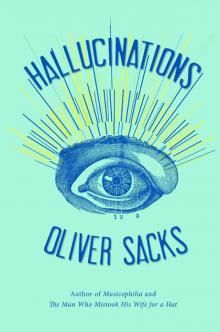 Hallucinations
Hallucinations Seeing Voices
Seeing Voices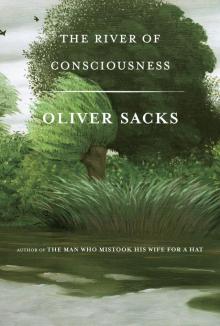 The River of Consciousness
The River of Consciousness Vintage Sacks
Vintage Sacks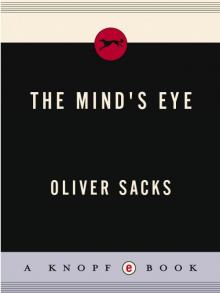 The Mind's Eye
The Mind's Eye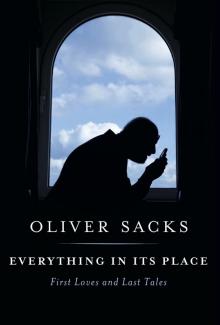 Everything in Its Place
Everything in Its Place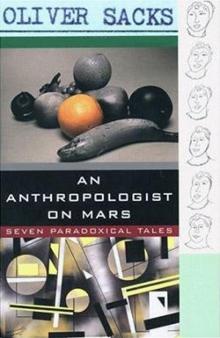 An Anthropologist on Mars (1995)
An Anthropologist on Mars (1995) Uncle Tungsten: Memories of a Chemical Boyhood (2001)
Uncle Tungsten: Memories of a Chemical Boyhood (2001)